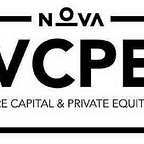Why micro-funds matter in a thriving VC market
In a venture capital market where everything is getting larger, micro-funds, those raising $50m or less, are proliferating. While the median seed deal size has gradually increased over the past years, micro-funds ‘ sizes have stayed the same as they continue to provide a unique perspective to the market.
In many aspects, 2021 has been a record year for venture capital. According to data from CB Insights, global venture funding reached a record $621 billion in 2021 — more than double the 2020 mark of $294 billion. Yet, the number of deals didn’t increase proportionately. As a result, the average and median deal sizes reached new all-time highs, climbing to $25 million and $5 million respectively. This behaviour can be observed across regions, investor categories, and deal stages.
The fundraising activity on the investor side has gone hand in hand with its startup counterpart. Allocators worldwide continue to flock to alternative investments — venture capital is no exception. Especially in the United States, 2021 has been a record year for venture capital fundraising, with more than $129 billion raised by US funds. A figure that was nearly 50% higher than 2020’s total. This came largely on the back of the record number of mega-funds closed, 63 of which received commitments of $500 million or more, pulling the average US venture capital fund size for the year up to $188 million.
For years now, a major trend within the venture industry has revolved around larger and larger funds. Back in 2018, Sequoia was raising $12 billion for its growth and venture fund and set a minimum check size of $250 million for its limited partners to participate. This was an effort to build up a “war chest” to compete against Softbank’s $100 billion mega-fund. Since then, many other VCs are following suit with this trend in raising massive funds, such as Battery Ventures or General Catalysts. There is certainly no shortage of capital available to back startups across all stages.
Thriving micro-funds
Meanwhile, micro-funds, those raising $50 million or under, have also bloomed, setting new records in terms of fundraising volume and fund count. This rise of micro-funds demonstrates a strong contrast to the narrative of a venture capital market that is growing larger and larger. With deal sizes, valuations, and mega-funds increasing, the purchasing power of micro-funds is limited. Yet, they have adapted to the changing landscape, offering different opportunities for LPs, companies, and new investment firms to access the venture market like never before. Despite the growing divide between micro-funds and the funds that make up most of the fundraising, these smaller vehicles have continued to drive trends from the beginnings of venture and benefit a range of stakeholders in the industry.
Benefits to the Venture Capital Ecosystems
Startups receive capital increasingly early and pre-seed investments have emerged over the past years. This has allowed micro-funds to invest without jeopardizing their strategies because of any capital constraints. Although the total raised by micro-funds since 2006 does not even add up to half of a Softbank Vision Fund, the investment power of these small funds is multiplied by the networks they bring into new ecosystems. Micro-funds often specialize in industries or geographies, giving them a very specific idea of what they want to invest in.
Benefits to LPs
VC can be difficult for LPs to enter. Many of the largest VC funds are raised through the same LPs that were involved with the VC firm’s previous funds. Micro-funds have provided a great opportunity for LPs that are either too small to access large funds or are looking to start off in a venture and test out other investment theses.
Benefits to Investors
Like LPs gaining access to venture, micro-funds have also been of interest for new managers to begin investing in VC. Even though data on the performance of micro-VCs is low, a Pitchbook analysis has pointed towards strong performance figures.
Micro-funds will continue to multiply in the venture capital market as, in many ways, they help democratize VC. They give access to capital and grow an investment firm or ecosystem, thereby opening the market for many participants. With the speed of change in the venture industry, capital will increasingly be deployed into smaller markets and underserved technologies which will give great opportunities for micro-funds.
This newsletter is fully independently produced by the members of the Nova Venture Capital and Private Equity Club. This club is run by students of the Nova School of Business and Economics.
You can directly access the sources we used:
KPMG. (2022). Venture Pulse Q4 2021. Global analysis of venture funding. KPMG.com. Available at: https://assets.kpmg/content/dam/kpmg/xx/pdf/2022/01/venture-pulse-q4-2021.pdf
Szkutak, R. (2022). How Venture Capital’s New Crop Of Micro Funds Punch Above Their Weight. Forbes.com. Available at: https://www.forbes.com/sites/rebeccaszkutak/2021/06/03/how-venture-capitals-new-crop-of-micro-funds-punch-above-their-weight/?sh=2e76bf536865
Stanford, K. (2022). PitchBook Analyst Note: Micro-Funding Opportunity. PitchBook.com. Available at: https://pitchbook.com/news/reports/q2-2022-pitchbook-analyst-note-micro-funding-opportunity
CB Insights. (2022). State Of Venture 2021 Report. CBInsights.com Available at: https://www.cbinsights.com/research/report/venture-trends-2021/
